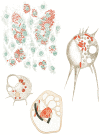Immunology's Coming of Age
- PMID: 31001278
- PMCID: PMC6456699
- DOI: 10.3389/fimmu.2019.00684
Immunology's Coming of Age
Erratum in
-
Corrigendum: Immunology's Coming of Age.Front Immunol. 2019 Jun 6;10:1214. doi: 10.3389/fimmu.2019.01214. eCollection 2019. Front Immunol. 2019. PMID: 31244830 Free PMC article.
Abstract
This treatise describes the development of immunology as a scientific discipline with a focus on its foundation. Toward the end of the nineteenth century, the study of immunology was founded with the discoveries of phagocytosis by Elias Metchnikoff, as well as by Emil Behring's and Paul Ehrlich's discovery of neutralizing antibodies. These seminal studies were followed by the discoveries of bacteriolysis by complement and of opsonization by antibodies, which provided first evidence for cooperation between acquired and innate immunity. In the years that followed, light was shed on the pathogenic corollary of the immune response, describing different types of hypersensitivity. Subsequently, immunochemistry dominated the field, leading to the revelation of the chemical structure of antibodies in the 1960s. Immunobiology was preceded by transplantation biology, which laid the ground for the genetic basis of acquired immunity. With the identification of antibody producers as B lymphocytes and the discovery of T lymphocytes as regulators of acquired immunity, lymphocytes moved into the center of immunologic research. T cells were shown to be genetically restricted and to regulate different leukocyte populations, including B cells and professional phagocytes. The discovery of dendritic cells as major antigen-presenting cells and their surface expression of pattern recognition receptors revealed the mechanisms by which innate immunity instructs acquired immunity. Genetic analysis provided in-depth insights into the generation of antibody diversity by recombination, which in principle was shown to underlie diversity of the T cell receptor, as well. The invention of monoclonal antibodies not only provided ultimate proof for the unique antigen specificity of the antibody-producing plasma cell, it also paved the way for a new era of immunotherapy. Emil Behring demonstrated cure of infectious disease by serum therapy, illustrating how clinical studies can stimulate basic research. The recent discovery of checkpoint control for cancer therapy illustrates how clinical application benefits from insights into basic mechanisms. Last not least, perspectives on immunology progressed from a dichotomy between cellular-unspecific innate immunity and humoral-specific acquired immunity, toward the concept of complementary binarity.
Keywords: antibody; cytokine; dendritic cell; immunology; lymphocyte; macrophage; phagocytosis; recombination.
Figures







Comment in
-
Commentary: Immunology's Coming of Age.Front Immunol. 2019 Sep 12;10:2175. doi: 10.3389/fimmu.2019.02175. eCollection 2019. Front Immunol. 2019. PMID: 31572385 Free PMC article. No abstract available.
References
-
- Silverstein AM. A History of Immunology, 2 ed. San Diego, CA: Academic Press; (2009).
-
- Behring EV. Nobel Prize in Physiology or Medicine 1901. Available online at: https://www.nobelprize.org/prizes/medicine/1901/summary/ (accessed March 20, 2019).
-
- Allison JP, Honjo T. Nobel Prize in Physiology or Medicine 2018. Available online at: https://www.nobelprize.org/prizes/medicine/2018/summary/ (accessed March 20, 2019).
Publication types
MeSH terms
LinkOut - more resources
Full Text Sources

